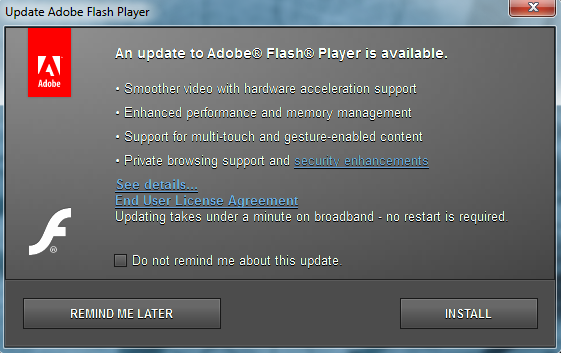Summary:
- This vulnerability affects: Adobe Flash Player running on all platforms and Adobe Air
- How an attacker exploits it: By enticing users to visit a website containing malicious Flash content
- Impact: In the worst case, an attacker can execute code on the user’s computer, potentially gaining control of it
- What to do: Download and install the latest version of Adobe Flash Player for your platform
Exposure:
Adobe Flash Player displays interactive, animated web content called Flash. Although Flash is optional, 99% of PC users download and install it to view multimedia web content. It runs on many operating systems, including mobile operating systems like Android.
 In a security bulletin released this week during Patch Day, Adobe released an update that fixes a dozen security vulnerabilities affecting Flash Player running on any platform. The bulletin doesn’t describe the flaws in much technical detail, but does say most of them consist of various types of memory corruption flaws. If an attacker can entice one of your users to visit a malicious website containing specially crafted Flash content, he could exploit many of these vulnerabilities to execute code on that user’s computer, with that user’s privileges. If your Windows users have local administrator privileges, an attacker could exploit this flaw to gain full control of their PCs.
In a security bulletin released this week during Patch Day, Adobe released an update that fixes a dozen security vulnerabilities affecting Flash Player running on any platform. The bulletin doesn’t describe the flaws in much technical detail, but does say most of them consist of various types of memory corruption flaws. If an attacker can entice one of your users to visit a malicious website containing specially crafted Flash content, he could exploit many of these vulnerabilities to execute code on that user’s computer, with that user’s privileges. If your Windows users have local administrator privileges, an attacker could exploit this flaw to gain full control of their PCs.
Though attackers aren’t exploiting these flaws in the wild yet, Adobe rates them as a “Priority 1” issues for Windows, Mac, and Linux users, and recommends you apply the updates within 72 hours. These vulnerabilities also affect other platforms as well, though not as severely. I recommend you update any Flash capable device as soon as you can.
As an aside, though Adobe promised a Reader update this month, they seem to have delayed it for some reason. You may want to keep an eye on Adobe’s Security page for more updates.
Solution Path
Adobe has released new versions of Flash Player to fix these issues. If you allow Adobe Flash in your network, you should download and install the new versions immediately. If you’ve enabled Flash Player’s recent “silent update” option, you will receive this update automatically.
You can download Flash for your computer at the link provided below. See the bulletin’s “Affected Software” section for more details on getting Flash updates for other platforms:
For All WatchGuard Users:
If you choose, you can configure the HTTP proxy on your XTM appliance to block Flash content. Keep in mind, doing so blocks all Flash content, whether legitimate or malicious.
Our proxies offer many ways for you to block files and content, including by file extension, MIME type, or by using very specific hexidecimal patterns found in the body of a message – a technique sometimes referred to as Magic Byte detection. Below I list the various ways you can identify various Flash files:
File Extension:
- .flv – Adobe Flash file (file typically used on websites)
- .fla – Flash movie file
- .f4v – Flash video file
- .f4p – Protected Flash video file
- .f4a – Flash audio file
- .f4b – Flash audiobook file
MIME types:
- video/x-flv
- video/mp4 (used for more than just Flash)
- audio/mp4 (used for more than just Flash)
FILExt.com reported Magic Byte Pattern:
- Hex FLV: 46 4C 56 01
- ASCII FLV: FLV
- Hex FLA: D0 CF 11 E0 A1 B1 1A E1 00
(Keep in mind, not all the Hex and ASCII patterns shared here are appropriate for content blocking. If the pattern is too short, or not unique enough, blocking with them could result in many false positives)
If you decide you want to block Flash files, the links below contain instructions that will help you configure your Firebox proxy’s content blocking features using the file and MIME information listed above.
- XTM Appliance with WSM 11.x
- Firebox X Edge running 10.x
- Firebox X Core and X Peak running Fireware 10.x
Status:
Adobe has released updates to fix these Flash vulnerabilities.
References:
This alert was researched and written by Corey Nachreiner, CISSP (@SecAdept)

Leave a Reply